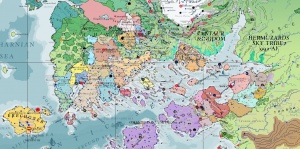Settings
There are several periods that have been chosen as rpg 'setting' periods. They have particular qualities and favor certain historical elements.
50 AI Setting
This is the time of sky migrations and pre-Yophenthean Empires.
950 AI Setting
The late Yophenthean Empire reached across the regions of the Pallathantic Sea. The setting is either within the empire or in a neighboring region, such as Thrace or Omre.
1283 AI, Age of Warriors and Mages
This historic period occurs after the collapse of most or all of the Yophenthean Successor States, including the Deavingeal Dynasty in southwestern Pytharnia. The Asbards have conquered the southern Rhaunve Valley and Medibgóëse colonists have settled in Gonfaloy. The Ambrasian Reformation, ca 1110 to 1140, has established the cult of the ancient sun god, Amrulon, as the state religion of the high Rhaunve River Valley and the Imzaha religion of Shagrela'al and the western Weshif desert is borne by missionaries into neighboring lands. The most powerful state in the Pallathantic is the Omandraline Empire of Sky, ruled by the genius Sorcerer-King, Omandral—but how long this prodigy of spellcraft and strategy can last is another matter. This period of history is before the first Thracian Empire, before the Golden Age of Sky, before the Chaos Rulers, and before the Isbajutha. Humans and dwarves have not discovered and developed titancraft. Religious cults of the late Yophenthean Empire linger on, such as the cult of Errignomon. While chaos gods are generally shunned, as they have been progressively since the time of Salmakhamer, they are not universally loathed and prohibited like they will be after the Isbajutha. Thus some leaders turn the eye the other way and small chaos cults are practiced in large cities, in the countryside, and in the wilds.
The 1283 AI setting is very roughly similar to the early and mid medieval period on earth, with the collapse of the last vestiges of the Roman Empire, the immigration of barbarian tribes, the spread of new cults and religions, including Islam, and the establishment of local tribal authorities.
The Omandraline Empire of Sky reaches over western Corundy, Ambrinqua, and Thyria. Omandral Sorcerer King rules these lands by the threat of his skyforce of sky tribe warriors and captive djinn. Having defeated the princes of Vimalia and the navy of the Aurician Republic of Goscundy, he has great influence in the rest of Corundy and in Lucacia.
Hieratic powers are still a force to be reckoned with and the temples of many different gods flourish. The cult of Arathrax and the power of the Arathracian Church prevails, despite the collapse of the Yophenthean Empire. Psychist powers are practiced by a few, especially Shaphrizite Incarnandists. Sunfather Greagal I rules the Arathracian Church and reigns, 1274 to 1286, as overseer of the faithful. Dwarvenfire is still the specialty of the dwarves, but is finding greater use among humans. Humans, namely Arathracian priests, have lost knowledge of Saint Iphiala's Stars which has emboldened some dwarves to use dwarvenfire weapons outside of their homelands. The damarissica, a smaller, more accurate dwarvenfire cannon, is used to protect the dwarves in their mountain fastnesses from surface invasions from giants, humans, orcs, and goblins.
The Incarnandina, Z'ayimáth kath Shazáth Pa'yóth, dwells in Jerushabla. During the 1200's, the T’ulphi’asi Line dies out and the transmission of the role of Incarnandina passes into the Ti’wi’alanthi Line.
Sky tribes continue to raid weaker settlements, streaming out in small groups from the Jaggudorn Mountains, either to return to their homelands with loot and captives or more likely to stay in the lands of Pytharnia, Eloaria, and further abroad. New improvements in skycraft have stretched the range of the sky tribes. Skycraft is no longer limited to sky tribes of the Jaggudorns, but used throughout much of the Pallathantic Region. The Zarajoveni Tribes remain in the western Adamantine Mountains, worshiping their pre-Imzaha, ancestral divinities. The Dz̧ahwatşabu, a dwarven galebelly, was first invented in the twelfth or thirteenth century in Gdelisica.
The land of Magdala lacks a single ruler and local governments prevail. The Flaminal College in Trevirs exercises many of the roles of government in the chief city and some want it to hold formal power over the whole land of Magdala.
A handful of ancient institutions for learning, the Guild Schools and Colleges continue to teach pupils the knowledge of the ancient past. These schools include Archcollege of Aturoksha (est. 314 AI), Archcollege of Divinities, (est. 872, Beh-Shelub), Archcollege of Johaulia, (est. 497), Archcollege of Jemhu, (est. 783), Archcollege of Mirrhaimo, (est. 374), Archcollege of the Yuligirn, (est. 853), Archcollege of Zamaclë, (est. 1067), Metallurgical School of Tauhad, (est. 248).
Legends include that of Saint Yusivailt's Rock.
1855 AI, Age of Steel and Dragons
This is the Age of Steel and Dragons. Civilization succumbs to the powers of Chaos.
1980 AI, Mage Tyrannies
Only a few years before the destruction-wreaking Voyage of the Chaos Fleet, the period of the Mage-Tyrannies saw the rise of numerous regional kinglets whose power was often as much a matter of chaos magic as it was due to politics and warfare. Not all rulers are chaos mages, but the trend increased into the twenty first century.
- Dominion of Useph-Re-Kaal
- Wizard Kingdom of the Three Isles
- Duchy of Aurice
- Sunfathership of Yophénthë, Eidadh IV, 1982 to 1985, slain by an Aio
- Duchy of Desthor
- Mage Republic of Narshad
- Priest-Kingdom of Shelekhumbia
- Kingdom of Shagrela’al
- Imzaami Kingdom of Khesheph
- Mage-Kingdom of Nu-Shahazu (Female Giant Queen, includes Shakhrilim and Kishkelumadh)
- Nifsazari Nomadic Half-Giants in Shelekhumbia west of the Adamantine Mountains (Adamantine Sierras) ca 1980 AI, south of Yephalah and north of Mage Kingdom of Nu Shahazu
2735 to 2747 AI, Titanpunk
This is the 'modern' year setting. Titancraft is well developed and numerous powerful states and empires control the lands of the earth. Humans are the predominant rulers.
See Also
| This article is a stub. It requires further development by the creator. |
